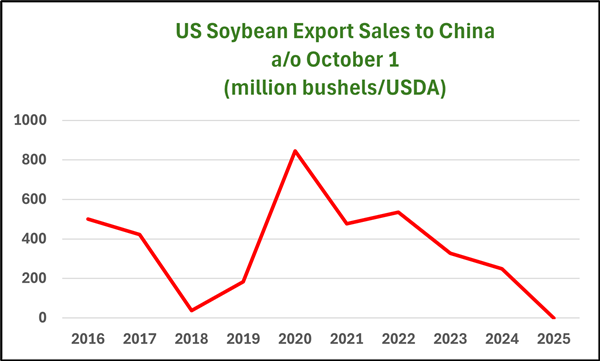By Mike Krueger*
One of the impacts of the U.S. government shutdown is that we will get nothing from the USDA. That means no daily or weekly export sales reports, no monthly WASDE (supply and demand) reports, none of the multitude of other reports (most of which nobody will miss). So we fly blind until the government goes back to work.
The USDA was scheduled to release the first sunflower production estimate in their October 9 reports, but those reports were also not released. The USDA had forecast record corn and soybean yields in their August and September reports. It was widely anticipated that their first sunflower yield estimate would also reflect record or near-record yields. Remember that the USDA previously had forecast a 50% increase in oil sunflower planted acres and an 8% decline in “other” sunflower planted acres.
There were a number of private pre-report corn and soybean production estimates circulating before the scheduled October 9 USDA reports, even though those reports were not released. The general attitude in the trade is that the U.S. corn yield might slip slightly while the U.S. soybean yield might be steady or slightly higher.
We are in one of those periods of time in U.S. and world markets where supplies everywhere are large. Record crop production in many of the major wheat, corn and soybean producing and exporting countries has taken the edge off of prices. Throw in the tariff wars, especially with China, and there is little reason for prices to rally.
The Russia/Ukraine war is approaching its four-year anniversary. There were significant concerns about Black Sea crop production and the ability to move that production out of Ukraine and the Black Sea to world buyers. The truth is, there’s been very little impact on either. Ukraine’s agricultural ministry announced this week that farmers there will plant more crops than last year. Recall when there were worries about insufficient farm labor, fuel, etc.?
U.S. wheat and corn export sales are the best they’ve been in years. Corn exports are forecast to set a new record this marketing year. The flipside is that the U.S. is about to harvest a record corn crop.
One analyst wrote that these markets are “dying by a thousand cuts.” There seems to be nothing but bearish news everywhere. There are only two real things that can slow the descent and maybe turn the tide. One is finally reaching a deal with China, even though we’ve already missed two-thirds of the soybean sales window to China. The other is adverse weather that threatens crop production someplace on earth.
There was another setback to China negotiations the second week in October when proposed trade talks apparently blew up over other issues. President Trump is rumored to be ready to impose even higher tariffs against China if the tone of trade talks doesn’t improve soon.
These are buyers’ markets and will remain so for a while longer.
The Trump administration is preparing a program to subsidize farmers for lost revenue due to the lack of soybean sales to China. Details of this will not be released until after the government shutdown is over. It’s interesting that the USDA Economic Research Service (ers.usda.gov) released their estimate of net farm income on September 3. Their analysis is forecasting the second highest net farm income in history despite the lack of soybean exports to China. Part of that equation is the forecast for a record soybean yield.

The major problem in the oilseeds markets is the total lack of export sales from the U.S. to China. As in zero. China has filled their plate with soybeans from Brazil, as they typically do; but this season they have topped it off with Argentine soybeans instead of U.S. soybeans.
This has been partly anticipated by the USDA, with a 175 million bushel reduction in the soybean export forecast. The problem is that a year ago at this time we had 250 million bushels of soybean sales on the books to China. This year we have none. That means the soybean export forecast might have to be trimmed again. The good news is that soybean crushing and domestic soybean usage will both set records. Soybean ending supplies will be about the same as last year, unless the export forecast is further reduced.
The accompanying table shows the level of U.S. soybean export sales to China as of October 1. Note that the last collapse in sales was in 2018 when President Trump had also imposed tariffs on China.
* Mike Krueger founded The Money Farm, and is now a senior analyst with World Perspectives, a Washington, D.C.-based consulting company. While the information in this article is believed to be reliable, marketing involves risk, and the author and The Sunflower assume no responsibility for its use.